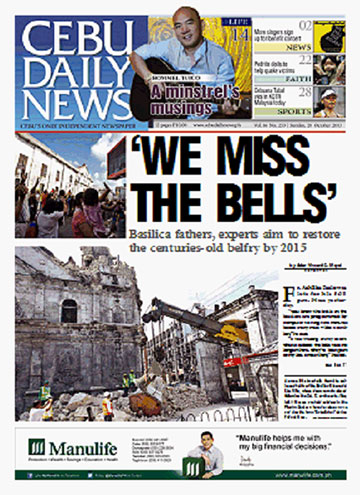
“You know the bells in the basilica are programmed by computer to ring five minutes before every Mass – like a carillon,” he said.
“I was waiting in my room. Then I realized the bells were no longer there. They’ve been part of my life. I miss them,” he said.
A crane was used last Friday to lift two centuries-old bells from the pavement in front of the basilica where the coral stone belfry had crashed after the 7.2 magnitude earthquake last Oct. 15.
The basilica has been closed to the public since then but daily masses continue in the quadrangle of the Pilgrim Center in front of the church.
Clearing operations are also in progress under close supervision of Agustinian fathers and conservation experts.
The debris is carefully sifted, numbered and recorded.
Fr. Harold Rentoria, OSA, hairman of the Commission on Cultural Heritage of the Augustinian Fathers, said the Escuela Taller de Intramuros is supervising the clearing operations to ensure that what is left will be preserved.
“Our concern now is to collect the stones from the basilica’s belfry and identify which of these can still be used,” Rentoria told CDN.
The big challenge is to restore the belfry, the crowning glory of the 18th century basilica, by 2015.
In 2015, the Agustinian religious order celebrates the 450th year of the finding of the Sto. Niño image in the ruins of a village in Cebu, the presence of the Agustinian friars in the Philippines, and the 50th anniversary of the church’s title as a “minor basilica” designated by the Vatican.
Architect Carlos Zafra of the University of San Carlos’ pool of heritage conservation experts, said the stones recovered from the ruined belfry can still be used in the renovation.
He said “reinforced concrete” can be used to rebuild the belfry’s foundations. He gave a tentative one-year timeframe for the work.
Escuela Taller de Intramuros is a school of various trades in the construction industry. It has undertaken the restoration of Intramuros and other heritage sites in the Philippines.
Fr. Rentoria said they have yet to decide how to go about restoring the basilica’s belfry which collapsed during the earthquake.
The powerful temblor also shook out stone chunks of the belfry of the Cebu Metropolitan Cathedral a block away but its collection of bells remained intact.
Rentoria, who had served as Commissioner of the National Commission for Culture and the Arts (NCCA), said they are being assisted by personnel from the Department of Public Works and Highways of Cebu.
Rentoria said different groups have conducted structural evaluations of the basilica and they will consolidate the reports before deciding whether the basilica is safe to be open again to the public.
Fr. Jonas Mejares, OSA, the rector, said they were advised to keep the debris because this will be used to make the new belfry look like the original structure.
Mejares, a native of Bohol, urged people not to lose faith.
“God has a reason. He has a message behind all this. We must realize that there is nothing more important in this world than to attain eternal life. God’s ways are not our ways. Let us seek refuge in Him,” he said.
“For me, it was a miracle that no one got hurt when the belfry crumbled.I call on everyone to pray. Let’s also put our resources together to help those severely affected by the earthquake,” he added.
A motorcycle rider passing by the basilica had an accident during the quake. A pedestrian pulled him off the street shortly before the stone belfry fell, with large chunks crushing the vehicle.
The basilica, built in the 18th century, is a major tourist attraction and home of the image of the Holy Child, Cebu’s patron and the oldest religious relic of Catholic tradition in the country.
On Friday, a special day of devotion for the Sto. Niño, Catholics from all walks of life gathered for Mass at the Pilgrim Center. On cue, they raised their arms and slowly waved at the sky as if greeting heaven when the hymn “Bato Balani” (Magnet of Love) was sung.
Although the basilica is temporarily closed, people continue to pay homage to the Sto. Niño image on an altar at the outdoor Pilgrim Center.
The church also continued to draw sight-seers and foreign tourists, who would pause to take photos of the collapsed belfry.
Architect Zafra, former manager of the Conservation Heritage Research Institute and Workshop (Cherish), said other old churches in Cebu should have a regular maintenance check of their structures.
Any damage caused by the earthquake needs expert advice to restore and repair them, he said, and advised that parish priests seek the assistance of the Archdiocesan Commission on Cultural Heritage of the Church.
The basilica is home of the image of the Sto. Nino de Cebu which was given as gift by Portuguese explorer Ferdinand Magellan to Cebu’s Queen Juana in 1521.
The current structure was built in 1735 and completed in 1739.